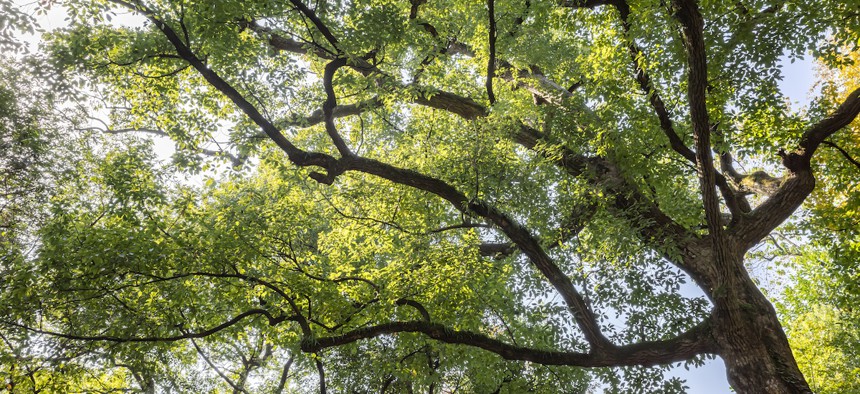A need for green: Cities look to trees to improve health, climate justice

lingqi xie/Getty Images
Cities and nonprofits are turning to trees as a possible solution to incoming climate crises and public health disparities.
Too much concrete and not enough trees can put residents in the hot seat—literally. Research shows a lack of trees or parks in urban communities can lead to higher surface temperatures, which increases residents’ risk of heat-related illnesses. Fewer green spaces can also contribute to poorer air quality, as harmful emissions that could otherwise be captured by trees linger in the atmosphere.
While tree shortages can be found in cities all over the country, they are found primarily in already disadvantaged communities due to discriminatory zoning laws, racial segregation and ongoing wealth disparities, said Benita Hussain, the tree equity lead at American Forests, a nonprofit dedicated to increasing forestry coverage and environmental equity in the U.S.
Historic redlining, or the discriminatory way mortgages and business loans were regularly denied in minority neighborhoods, “allowed for services and amenities to develop in certain places” and not others, Hussain said. Some of those amenities include tree-friendly parks and green spaces, which were left out of communities that lacked the financial capabilities to include them.
As a result, historically lower income communities are often more vulnerable to extreme heat and climate impacts than higher income areas, creating environmental and health inequity between neighborhoods.
Those trends could be reversed with the help of trees, Hussain said. Trees can provide shade during hot seasons, lowering urban temperatures and even reducing the greenhouse effect caused by emissions. A December 2022 study, for example, showed that New York City’s tree canopies, shrubs and lawns helped soak up about 40% of human-caused carbon emissions in the city. Trees can even mitigate the effects of flooding, Hussain said, by absorbing more stormwater than bare streets and sidewalks.
To help city managers bridge the tree gap to foster more equitable climate and health conditions, last month American Forests partnered with three other organizations— Green Latinos, Groundwork USA and One Tree Planted—to form the Tree Equity Alliance, Hussain said.
The alliance will leverage the Tree Equity Score tool, which visualizes and grades tree coverage at the state, county and local level, to help communities target resources for canopy expansion where they are needed most, American Forests said in an Aug. 7 statement announcing expansion of the tool.
Tree canopy data comes from the Google Environments Insights Explorer and is aggregated by census block groups, according to the tool’s website. The map will be updated as new data becomes available. The data will help the alliance prioritize under-resourced communities so it can offer cities, nonprofits and community groups technical assistance, training and funding opportunities that support tree growth and maintenance efforts. The alliance aims to mobilize cities’ data-driven environmental and health justice goals.
Officials can leverage the data to “build a case” for local, federal or private funds to further develop their urban tree canopy or bolster their applications for urban forestry grants, Hussain said. The Tree Equity Score tool can also help cities monitor their tree canopy progress in relation to other communities.
Some cities have already developed their own tree maps to help guide canopy equity projects. The Chicago Region Trees Initiative, or CRTI—whose partners include American Forests, the city’s Department of Health and its Metropolitan Agency for Planning—manages a tree canopy map that highlights tree distribution, temperature, flood risk, air quality and vulnerable populations and areas in the city.
The map “is something elected officials can easily visualize and understand … to make change in their community,” said CRTI Director Lydia Scott. “If they can see the benefits, the challenges or the inequities that are going on in their community, it’s easier for them to be able to allocate those resources.”
Boston is also leveraging tree data to guide its Urban Forest Plan, which aims to foster tree development in historically underserved areas and improve maintenance of already existing trees. Launched by Mayor Michelle Wu in 2022, the plan includes a strategy for equitably expanding the city’s tree canopy, based on an assessment of tree coverage from 2014 to 2019 when the canopy was relatively stable. An interactive map accompanied the 2020 assessment showing officials where tree coverage was most needed.
“This is not just about trees,” Hussain said, “This is about climate justice, this is about public health [and] this is about lives being saved across the country.”






